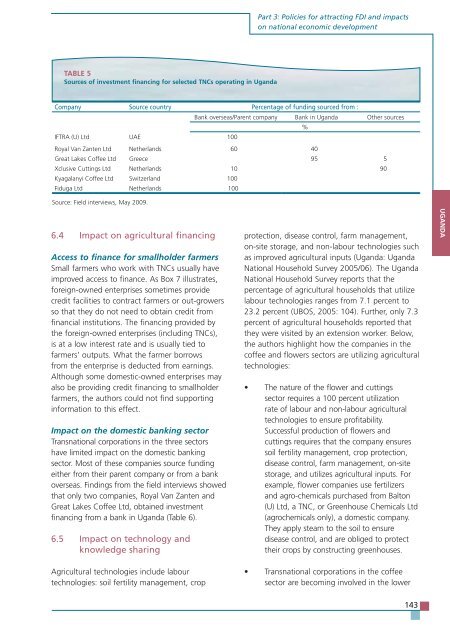TRENDS AND IMPACTS OF FOREIGN INVESTMENT IN DEVELOPING COUNTRY AGRICULTURE
TRENDS AND IMPACTS OF FOREIGN INVESTMENT IN DEVELOPING COUNTRY AGRICULTURE
TRENDS AND IMPACTS OF FOREIGN INVESTMENT IN DEVELOPING COUNTRY AGRICULTURE
Create successful ePaper yourself
Turn your PDF publications into a flip-book with our unique Google optimized e-Paper software.
TABLE 5<br />
Sources of investment financing for selected TNCs operating in Uganda<br />
6.4 Impact on agricultural financing<br />
Access to finance for smallholder farmers<br />
Small farmers who work with TNCs usually have<br />
improved access to finance. As Box 7 illustrates,<br />
foreign-owned enterprises sometimes provide<br />
credit facilities to contract farmers or out-growers<br />
so that they do not need to obtain credit from<br />
financial institutions. The financing provided by<br />
the foreign-owned enterprises (including TNCs),<br />
is at a low interest rate and is usually tied to<br />
farmers’ outputs. What the farmer borrows<br />
from the enterprise is deducted from earnings.<br />
Although some domestic-owned enterprises may<br />
also be providing credit financing to smallholder<br />
farmers, the authors could not find supporting<br />
information to this effect.<br />
Impact on the domestic banking sector<br />
Transnational corporations in the three sectors<br />
have limited impact on the domestic banking<br />
sector. Most of these companies source funding<br />
either from their parent company or from a bank<br />
overseas. Findings from the field interviews showed<br />
that only two companies, Royal Van Zanten and<br />
Great Lakes Coffee Ltd, obtained investment<br />
financing from a bank in Uganda (Table 6).<br />
6.5 Impact on technology and<br />
knowledge sharing<br />
Agricultural technologies include labour<br />
technologies: soil fertility management, crop<br />
Part 3: Policies for attracting FDI and impacts<br />
on national economic development<br />
Company Source country Percentage of funding sourced from :<br />
Bank overseas/Parent company Bank in Uganda<br />
%<br />
Other sources<br />
IFTRA (U) Ltd UAE 100<br />
Royal Van Zanten Ltd Netherlands 60 40<br />
Great Lakes Coffee Ltd Greece 95 5<br />
Xclusive Cuttings Ltd Netherlands 10 90<br />
Kyagalanyi Coffee Ltd Switzerland 100<br />
Fiduga Ltd Netherlands 100<br />
Source: Field interviews, May 2009.<br />
protection, disease control, farm management,<br />
on-site storage, and non-labour technologies such<br />
as improved agricultural inputs (Uganda: Uganda<br />
National Household Survey 2005/06). The Uganda<br />
National Household Survey reports that the<br />
percentage of agricultural households that utilize<br />
labour technologies ranges from 7.1 percent to<br />
23.2 percent (UBOS, 2005: 104). Further, only 7.3<br />
percent of agricultural households reported that<br />
they were visited by an extension worker. Below,<br />
the authors highlight how the companies in the<br />
coffee and flowers sectors are utilizing agricultural<br />
technologies:<br />
The nature of the flower and cuttings<br />
sector requires a 100 percent utilization<br />
rate of labour and non-labour agricultural<br />
technologies to ensure profitability.<br />
Successful production of flowers and<br />
cuttings requires that the company ensures<br />
soil fertility management, crop protection,<br />
disease control, farm management, on-site<br />
storage, and utilizes agricultural inputs. For<br />
example, flower companies use fertilizers<br />
and agro-chemicals purchased from Balton<br />
(U) Ltd, a TNC, or Greenhouse Chemicals Ltd<br />
(agrochemicals only), a domestic company.<br />
They apply steam to the soil to ensure<br />
disease control, and are obliged to protect<br />
their crops by constructing greenhouses.<br />
Transnational corporations in the coffee<br />
sector are becoming involved in the lower<br />
143<br />
UG<strong>AND</strong>A


